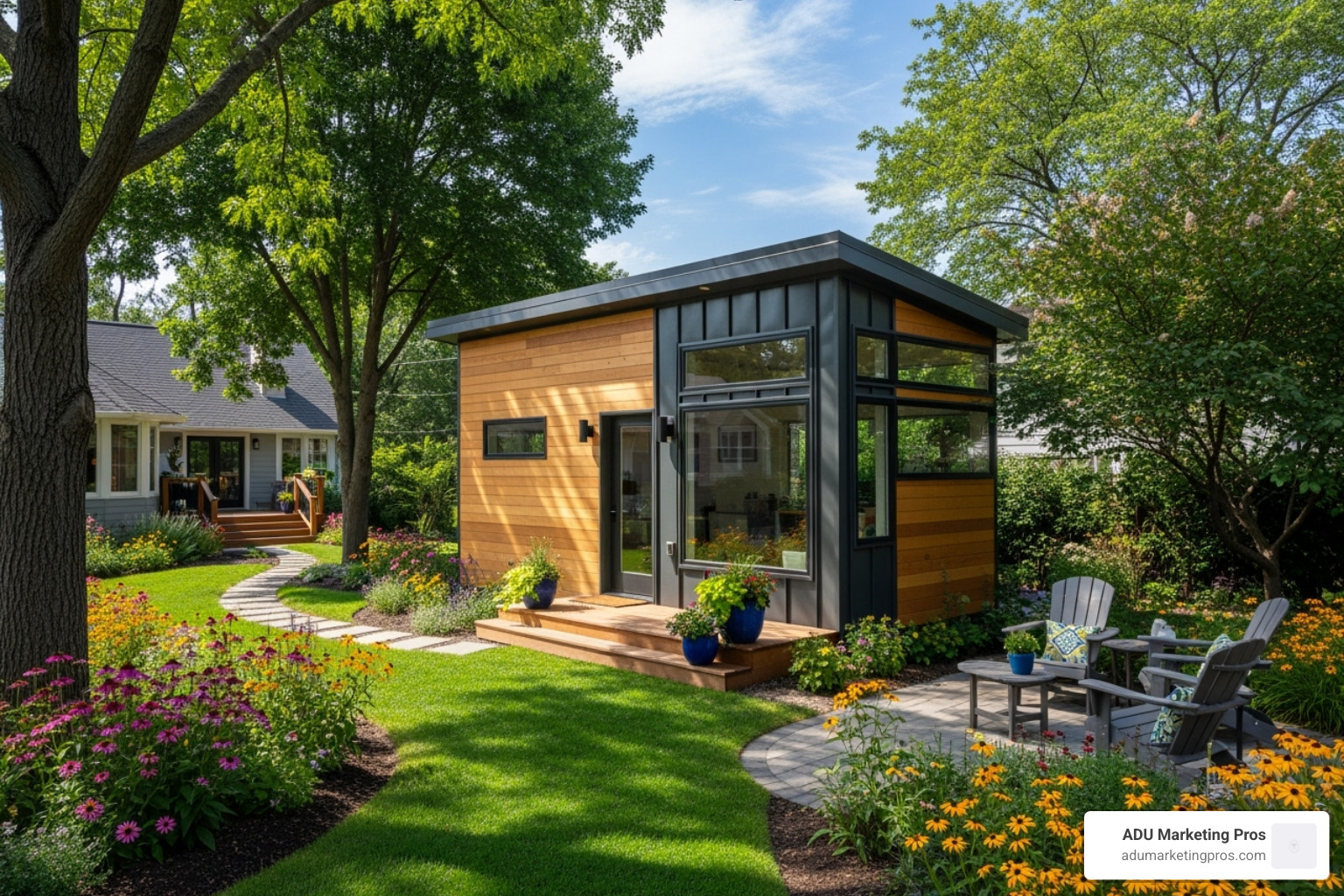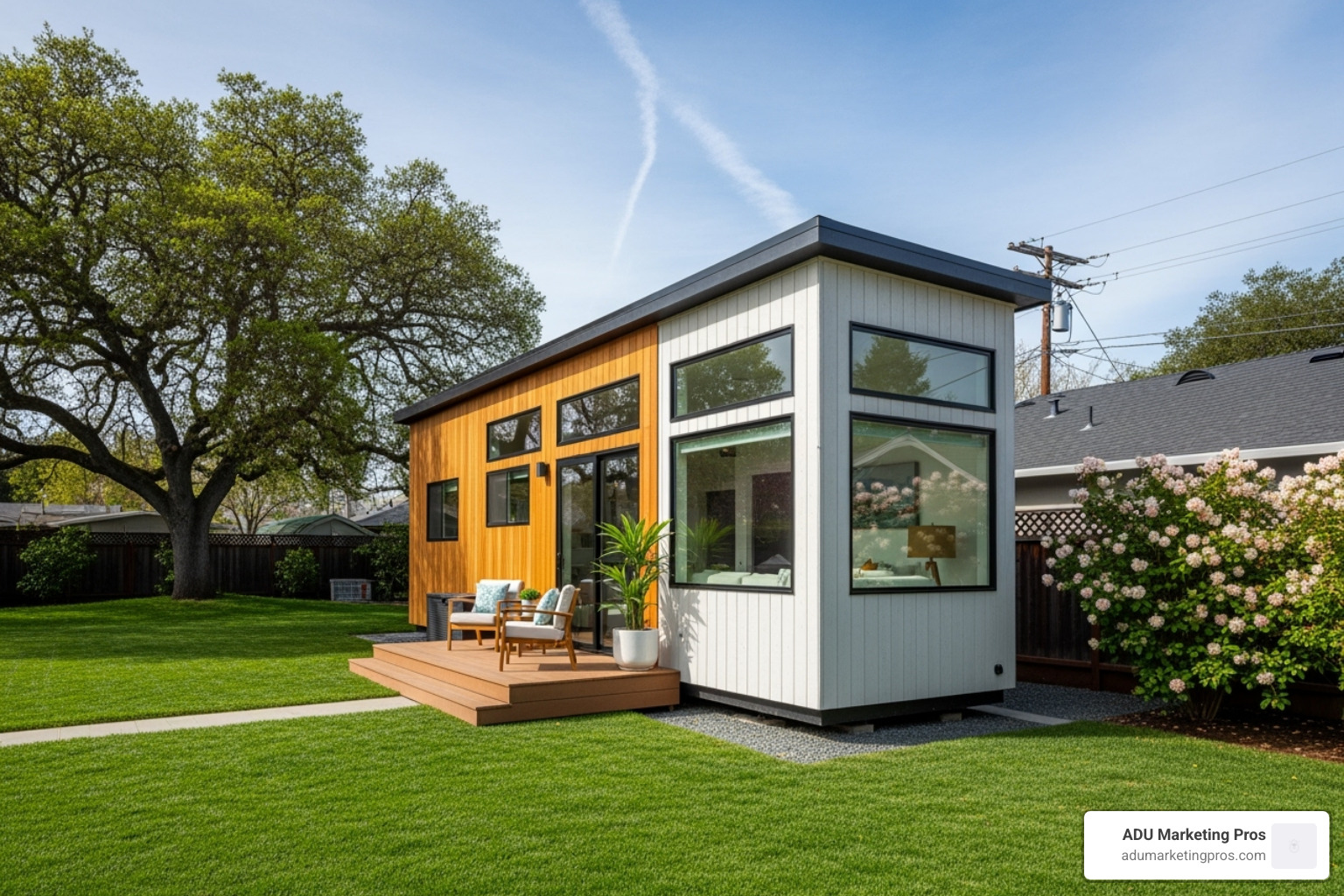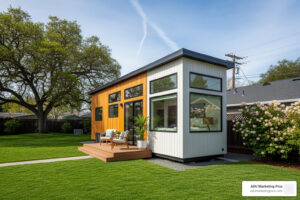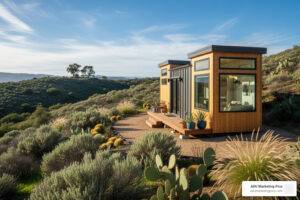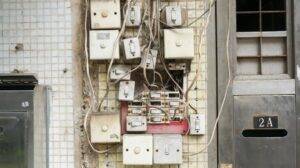Why Portable ADUs Are Revolutionizing Backyard Living
Portable ADU for sale options are changing how homeowners add living space. These factory-built units arrive nearly complete, install in weeks instead of months, and offer significant cost savings over traditional construction. They represent a fundamental shift toward flexible, affordable, and fast housing solutions.
Quick Answer: What You Need to Know About Portable ADUs
- Types: Modular units (permanent), shipping container homes (industrial), and tiny homes on wheels (mobile).
- Price Range: $30,000 to $100,000+ for the unit, depending on size and finishes.
- Timeline: As little as 6-8 weeks from order to installation for some models.
- Key Benefits: Faster installation, predictable costs, minimal site disruption, and potential for relocation.
Traditional ADU construction can take 12-18 months and cost over $200,000. Portable ADUs offer a stark contrast. Built in controlled factory environments, they eliminate weather delays and ensure consistent quality. You’re buying a finished product that gets delivered and installed, not starting a lengthy construction project in your backyard.
These units are increasingly sophisticated, featuring full kitchens, bathrooms, and energy-efficient systems. Whether for rental income, family members, or a home office, they provide practical, modern living spaces. However, you still need to steer local zoning laws, secure permits, prepare your site, and connect utilities. This guide will walk you through everything you need to know to make an informed decision.
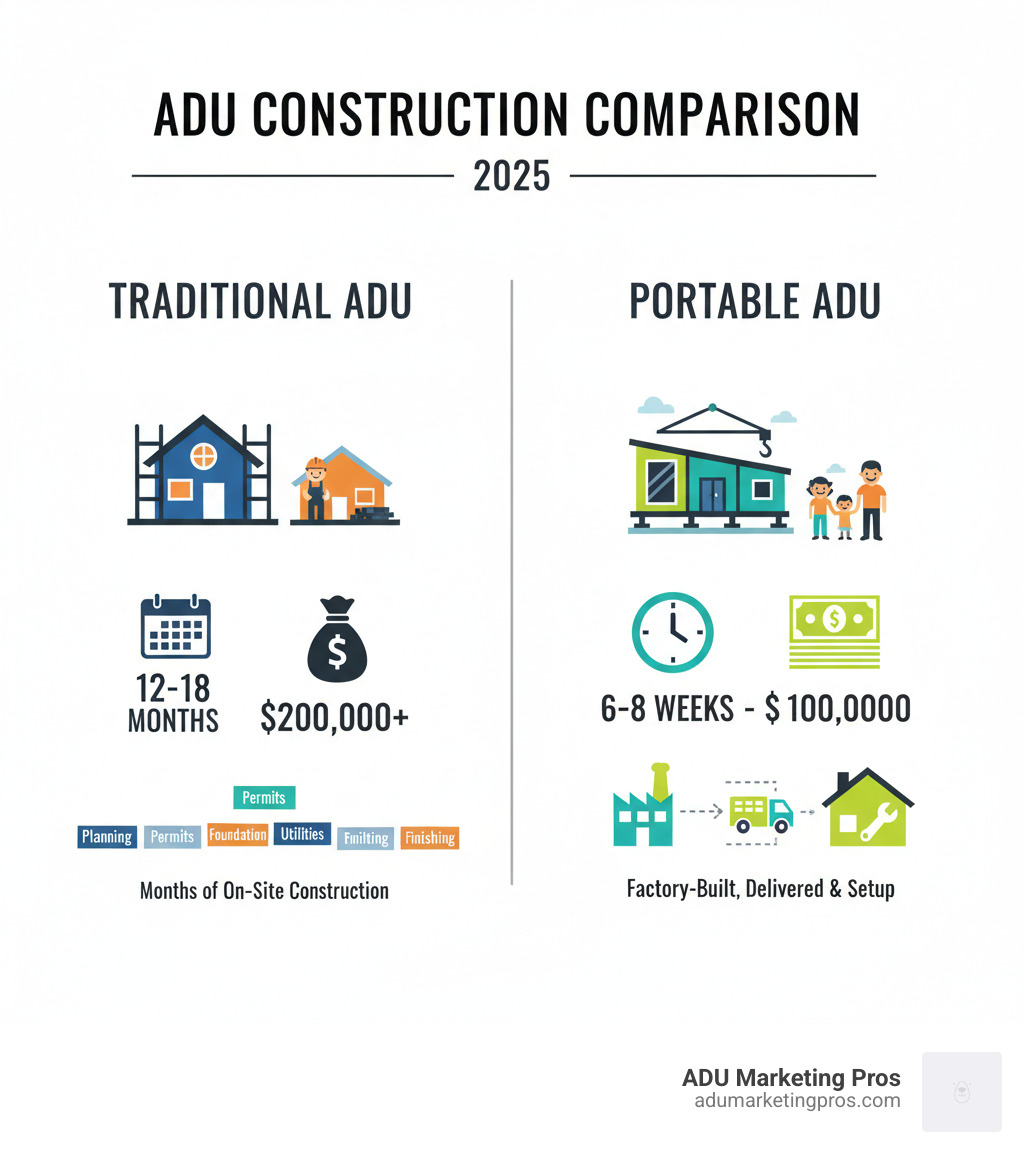
Why Choose a Portable ADU? The Key Benefits
Traditional ADU construction often means months of noise, dust, and unexpected costs. Portable ADU for sale options offer a streamlined alternative by moving the bulk of the construction process into a controlled factory setting. This changes the entire experience of adding living space to your property.

Speed of Construction: From Dream to Reality, Faster!
Factory-built efficiency is the secret to a faster timeline. While you handle site prep and permits, your ADU is assembled in a climate-controlled facility, free from weather delays or subcontractor issues. Manufacturers can often deliver a unit ready for occupancy in just 6-8 weeks. The on-site installation itself is remarkably quick, often taking only a few days. This minimal disruption means your daily life—and your relationship with your neighbors—remains intact.
Cost-Effectiveness: Predictable Pricing, Reduced Labor
Portable ADUs offer significant savings, with prices for most units ranging from $30,000 to $100,000, compared to $200,000+ for many traditional builds. The key benefit is cost predictability. With a factory-built unit, the price is set upfront, eliminating surprises from fluctuating labor or material costs. This efficiency is achieved through reduced waste, bulk material purchasing, and streamlined assembly, with savings passed on to you. While you still need to budget for site work, delivery, and utilities, the largest expense is locked in. For a detailed breakdown, see our guide on Prefab ADU California Cost.
Flexibility and Mobility: Your Asset, Your Rules
Unlike permanent structures, some portable ADUs offer the ability to relocate. Tiny homes on wheels are fully mobile, while even some modular units can be moved with specialized equipment. This flexibility is invaluable for evolving family needs, such as housing a recent graduate temporarily or adapting to changes in a multi-generational living arrangement. You’re not just building a structure; you’re investing in a versatile asset that can adapt to your life’s changes.
Sustainability: Good for Your Wallet, Good for the Planet
Factory construction is inherently more sustainable. Precision cutting and controlled processes dramatically reduce material waste compared to on-site building. Many manufacturers also prioritize eco-friendly features, such as high-grade insulation, double-glazed windows, and energy-efficient HVAC systems. Some, like ORCA, use locally sourced and recyclable materials. This focus on sustainability not only lowers your carbon footprint but also reduces your monthly utility bills. Explore our collection of Modern Prefab Granny Flats to see how style and sustainability can coexist.
Exploring the Main Types of Portable ADU for Sale
When shopping for a portable ADU for sale, you’ll find a variety of options, each with distinct advantages. Choosing the right one depends on your aesthetic preferences, functional needs, and long-term goals. For a broad overview of factory-built options, visit our page on ADU Modular Homes.
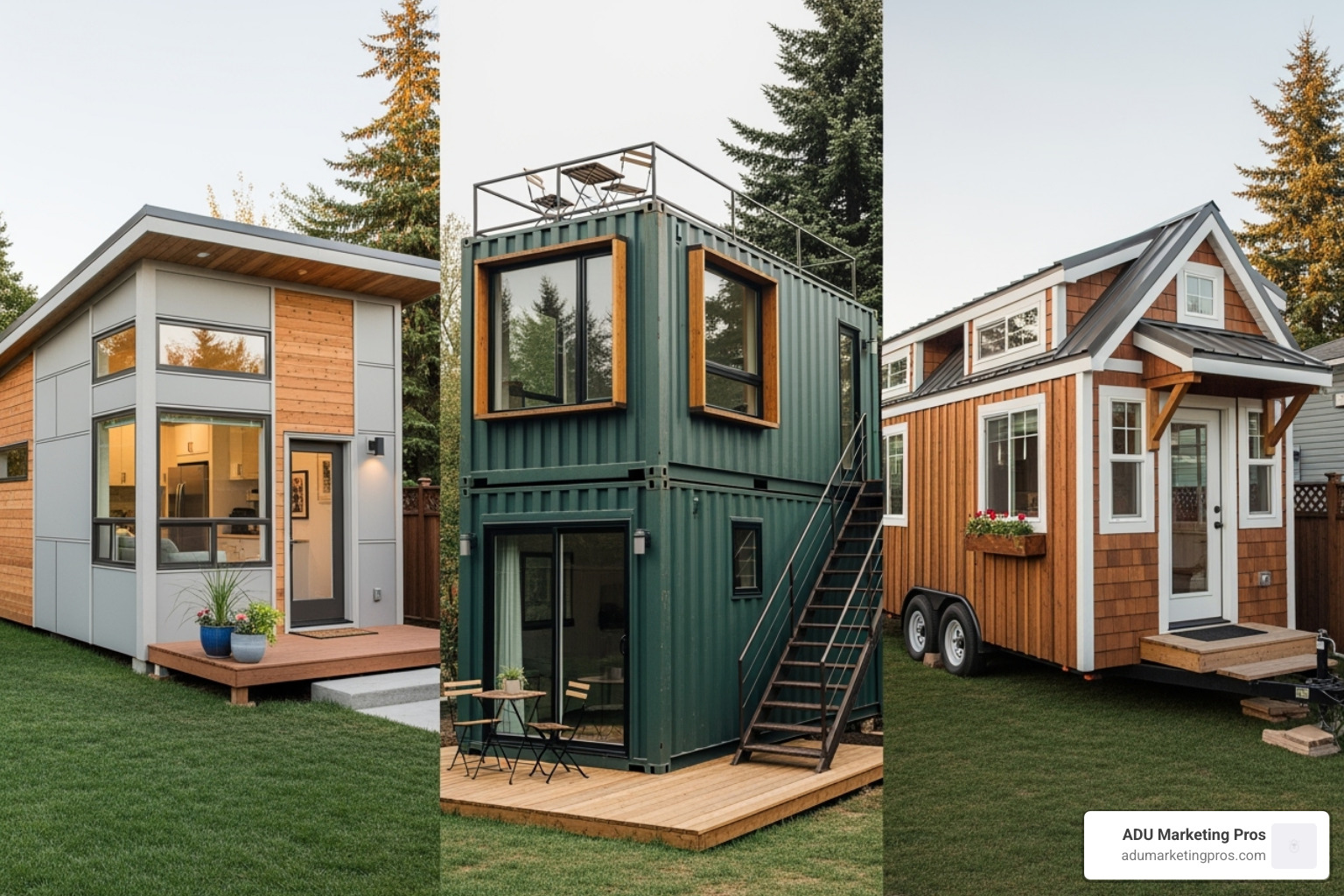
Modular ADUs: The Prefab Powerhouse
Modular ADUs are built in sections (modules) in a factory, then transported to your property and assembled on a permanent foundation. These units are constructed to meet or exceed local building codes, making them legally permanent homes. The quality often surpasses traditional stick-built homes due to the precision of factory construction. With a wide array of designs from modern to farmhouse, they come fully equipped with kitchens, bathrooms, and proper insulation.
Modular ADUs are an excellent long-term investment, perfect for rental properties, in-law suites, or dedicated home offices that add significant value to your property. For state-specific information, our guide to ADU Modular Homes California is a valuable resource.
Shipping Container Homes: Industrial Chic Meets Modern Living
Shipping container homes repurpose industrial steel boxes into durable, secure, and surprisingly comfortable living spaces. Their inherent strength makes them resistant to extreme weather, while the corrugated steel exterior offers a distinct industrial-chic aesthetic. Designers can customize these containers with large windows, stack them for multi-story homes, or arrange them to create private courtyards. This upcycling is an eco-friendly choice that gives new life to existing materials. They are ideal for home offices, art studios, or unique minimalist dwellings.
Tiny Homes on Wheels (THOWs): Ultimate Freedom and Flexibility
Built on a trailer chassis, tiny homes on wheels offer true mobility. Typically classified as RVs, they can sometimes simplify permitting, though you must verify local regulations. This legal distinction is their biggest advantage and biggest hurdle, varying widely by municipality. THOWs are perfect for those who desire a minimalist lifestyle, work remotely, or want the freedom to move without selling a property. Many are equipped with off-grid features like solar panels and composting toilets, offering true independence. If you’re considering compact living, our guide to 400 Square Foot ADU Plans offers insights into smart space planning.
From Purchase to Placement: A Complete Buyer’s Guide
Buying a portable ADU for sale is a significant investment. This guide will walk you through the key considerations, from initial design choices to final installation, ensuring you make an informed decision.
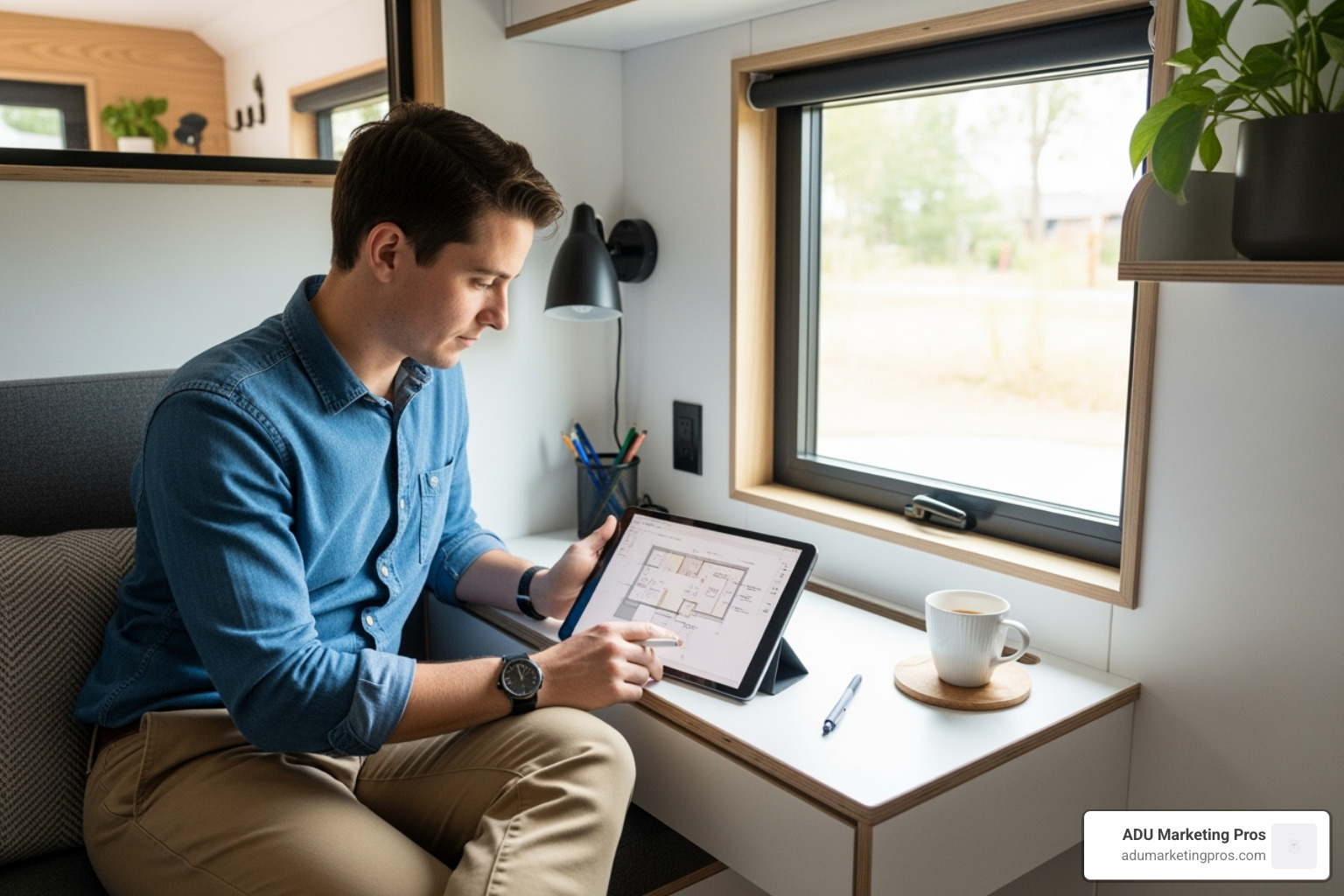
Key Features and Amenities to Look For
Functionality and long-term comfort are paramount. Look for efficient layouts that maximize space, often found in well-designed Studio ADU Floor Plans. Pay close attention to kitchen and bathroom quality, as these are critical for daily use. Ensure appliances, counter space, and fixtures meet your needs. Finally, don’t overlook insulation and energy efficiency. High-quality insulation, double-glazed windows, and efficient HVAC systems will impact your comfort and utility bills for years to come.
Understanding the Full Cost of a portable ADU for sale
The sticker price is just the starting point. The base unit price ($30,000 – $166,000+) will vary based on size, finishes, and whether you choose a basic shell or a fully finished turnkey unit. Be sure to budget for these additional costs:
- Site Preparation: Grading, excavation, and drainage.
- Foundation: Concrete slab or pier system for modular units.
- Delivery: Varies by distance and site accessibility (crane service may be needed).
- Utility Hookups: Connecting water, sewer, and electricity by licensed professionals.
- Permits: Fees for building permits, inspections, and local impact fees.
For financing, options include personal loans, home equity loans (HELOCs) for permanent ADUs, and chattel or RV loans for tiny homes on wheels. Many manufacturers also offer direct financing or partnerships with lenders. For more on budgeting, see our guide on Prefab ADU California Cost.
The Installation Process and Timeline
The streamlined installation is a major advantage. The process generally follows these steps:
- Site Preparation: While your ADU is built, your site is cleared, graded, and the foundation is prepared. This can take 2-4 weeks.
- Delivery: The completed unit or modules arrive on a truck and are placed by a crane.
- Assembly & Hookups: Modules are joined, and licensed professionals connect water, sewer, and electrical systems.
- Final Inspections: A local building inspector verifies that the unit meets all codes before granting occupancy.
The entire timeline, from order to move-in, is typically 6-8 weeks for modular units—a fraction of the 12-18 months required for traditional construction.
Lifespan, Maintenance, and Potential Challenges
A well-built modular ADU can last 50-100 years, similar to a traditional home, while a tiny home on wheels has an expected lifespan of 30-50 years. Longevity depends on build quality and regular maintenance, such as cleaning, roof inspections, and checking utility connections. Potential challenges include trickier financing for mobile units, an uncertain resale market, and the inherent space limitations of compact living.
Navigating the Legal Maze: Permits and Zoning
Portable ADUs do not bypass local regulations. Before you buy, you must understand:
- Zoning Laws: These dictate setback requirements (distance from property lines), size limits, and height restrictions. Rules in Los Angeles differ from San Jose or Palo Alto.
- Building Codes: Permanent ADUs must comply with state and local building codes for safety and structural integrity. The International Code Council provides the basis for most local codes.
- Permanent vs. Temporary: Modular units on foundations are permanent real property. Tiny homes on wheels are often classified as RVs, with varying rules for long-term occupancy.
Always contact your local planning department first. They can provide specific rules for your property. In California, the state has streamlined many ADU regulations; the California Department of Housing and Community Development is an excellent resource. Using Pre-Approved ADU Plans available in many cities can also expedite the permitting process.
Frequently Asked Questions about Portable ADUs
As you consider a portable ADU for sale, many questions will arise. Here are concise answers to some of the most common queries we receive.
How long does a portable ADU last?
The lifespan depends on the type and quality. A modular ADU built to residential building codes on a permanent foundation can last 50-100 years, just like a traditional house. A tiny home on wheels (THOW), built more like an RV, typically has an expected lifespan of 30-50 years. In both cases, proper maintenance is key to maximizing longevity.
Can I finance the purchase of a portable ADU?
Yes, several financing options are available. For modular ADUs on permanent foundations, you can often use traditional financing like a home equity loan (HELOC) or a construction loan. For tiny homes on wheels, which are considered personal property, RV loans, chattel mortgages, or personal loans are common. Many manufacturers also offer direct financing or have partnerships with lenders who specialize in these products.
What should I look for when choosing a portable ADU for sale?
Focus on these key factors to make the best choice:
- Build Quality: Examine the materials, from framing and insulation to windows and roofing. Don’t hesitate to ask the manufacturer for detailed specifications.
- Turnkey vs. Shell: Decide if you want a fully finished (turnkey) unit ready for move-in, or a basic (shell) unit that you finish yourself. Be realistic about your budget, time, and DIY skills.
- Code Compliance: This is non-negotiable. Ensure the unit you’re considering can meet your local zoning and building codes before you purchase. A reputable manufacturer should be able to help with this.
- Manufacturer Reputation: Research the company’s history, read customer reviews, and check their warranty.
- Features: Choose a layout and amenities that fit your intended use, whether it’s for a rental, office, or family. Exploring various ADU Building Plans can help clarify your needs.
Conclusion: Is a Portable ADU Right for You?
We’ve explored portable ADU for sale options, from their game-changing benefits to the practical steps of buying and installing one. The advantages are clear: the speed of installation, cost predictability, and flexibility of a relocatable asset make them a compelling alternative to traditional construction. Combined with the sustainability of factory-built, energy-efficient designs, it’s easy to see why the market is booming.
Whether you need a guest house, rental unit, or home office, a portable ADU offers a genuine solution. You now understand the differences between modular units, container homes, and tiny homes on wheels, and you know to prioritize features, budget for the full cost, and steer local laws. Armed with this knowledge, you can make a confident choice that adds real value to your property and your life.
This shift towards adaptable, efficient housing is more than a trend—it’s the future. If you’re a builder or architect leading this change, ADU Marketing Pros can help you connect with motivated buyers. We specialize in targeted marketing for the ADU sector, helping you showcase your expertise and grow your business.
Ready to take the next step? Find the perfect modern prefab granny flat for your property and start building the future you envision.
